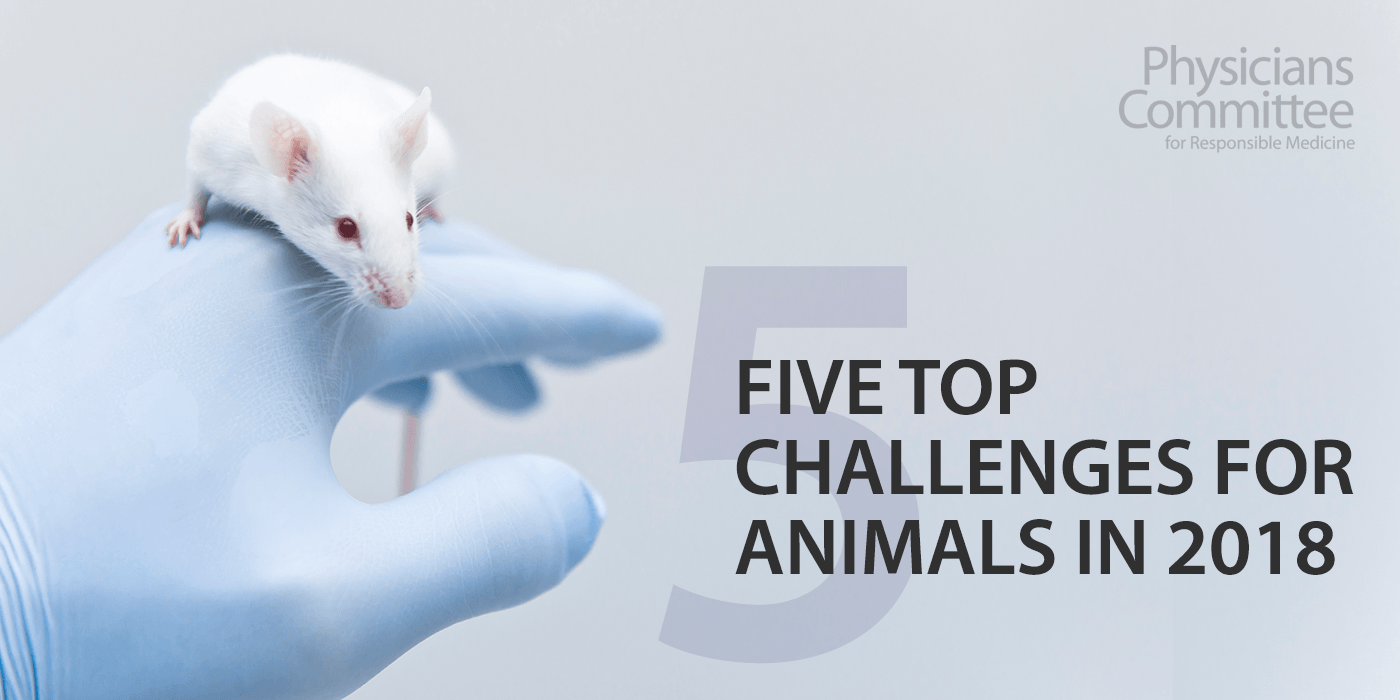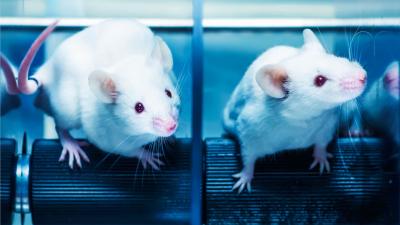Looking Ahead: Five Top Challenges for Animals in 2018

1. Animals Are Killed in Military and Medical Training
For years, the Physicians Committee and others have been pushing the Department of Defense to stop using goats and pigs to train medics and corpsmen (the Navy’s equivalent to medics). In these courses, animals are shot with firearms, stabbed, and dismembered. But jaw-droppingly realistic devices are available that replicate human anatomy, and some parts of the military are getting the message that these devices are better than nonhuman animals. We have already started the year strong, bringing to light the unauthorized use of animals by the Marine Corps and highlighting efforts within that branch of the military to replace animals. We also partnered with former M*A*S*H actors Jamie Farr and Mike Farrell and placed three billboards in San Antonio, Texas, to bring this issue to the attention of the Army Surgeon General. We have plenty more planned in the months ahead.
2. FDA Regulations Still Mandate Animal Testing
While we have succeeded in changing law and policy in the chemical sector, and now U.S. law states the Environmental Protection Agency (EPA) and the chemical industry must use and develop alternatives to animal testing, the Food and Drug Administration (FDA) lags behind. Current FDA regulations were established decades ago and do not provide flexibility to support modern science. Many regulations mandate that animal tests must be conducted prior to clinical trials in humans. However, drug development stakeholders—including the FDA itself, other federal agencies and private industry—now acknowledge that animal tests fail to predict human outcomes 95 percent of the time. Through the Preclinical Innovation and Patient Safety (PIPS) initiative, we have recommended the FDA update the regulations to allow for use of any scientifically evaluated preclinical approach, whether or not it involves animals. As part of regulatory reform at FDA, we combed through agency-wide regulations to identify specific regulations that need to be changed and provided proposed language and justification. We will continue to provide input to FDA on this issue and push for updated regulations. We are hopeful that 2018 is the year of regulation change, as our recommended changes complement roadmaps recently unveiled by the FDA and the Interagency Coordinating Committee on the Validation of Alternative Methods (ICCVAM) that aim to improve testing by moving away from animal tests.
3. Animal Research Interests Seek to Decrease Protections for Animals in Labs
A troubling new effort led by organizations that represent animal experimenters and their institutions aims to drastically cut protections for animals in laboratories. Essentially, they would like to create an oversight system that allows laboratories to self-regulate—when federal laws and government enforcement are already extremely lax. One of their recommendations is to drastically reduce how often most research facilities are inspected by the U.S. Department of Agriculture (USDA), which would significantly impair the public’s ability to monitor those facilities’ compliance with the law. In addition, USDA is proposing recognizing third-party inspections of research facilities, which would ask animal experimenters to help monitor themselves. The Physicians Committee is working with a large coalition of organizations to lobby Congress, the USDA, and the National Institutes of Health (NIH) to maintain or even strengthen current laws and regulations—not weaken them. In the months ahead, we'll be asking our supporters to contact these agencies and likely their members of Congress.
4. Government Budget Jeopardizes Funding For Human-Based Research
Last year, the Administration proposed major budget cuts for the EPA - nearly half of current levels. EPA funding cuts put the future of human-based research at stake because a lack of funds would inhibit EPA's ability to continue developing modern safety assessment methods that do not use animals. We lobbied to maintain the research budget for alternatives – and won! But the work continues. The Trump Administration’s recently-released budget cuts this funding from EPA again. The National Institutes of Health (NIH) has begun funding some really excellent human-focused research such as the National Center for Advancing Translational Sciences (NCATS) and small business grants to companies developing alternatives. However, the research funds directed towards human-based testing are a drop in the bucket compared to research dollars invested in animal testing. In order to quickly and responsibly develop and integrate modern, predictive testing approaches, we must call on our government to increase funding of research that can be expected to be more predictive for humans because it is based on human cells, tissues and biological processes.
5. High-Quality Human Cells and Tissues For Research Are Not Easy To Obtain
While many people understand the reasons for human-based research, using human cells and tissues, fewer people understand how these tissues are obtained for research. One way human cells and tissues are obtained are as byproducts of surgery. Many of us have the option to donate tissue to research that would otherwise be discarded. However, this option is not always presented to patients. We must increase the availability of human cells and tissues used for research, by educating the public and beginning a discussion on best practices for tissue procurement. We will bring together stakeholders to surmount some of these practical problems.








